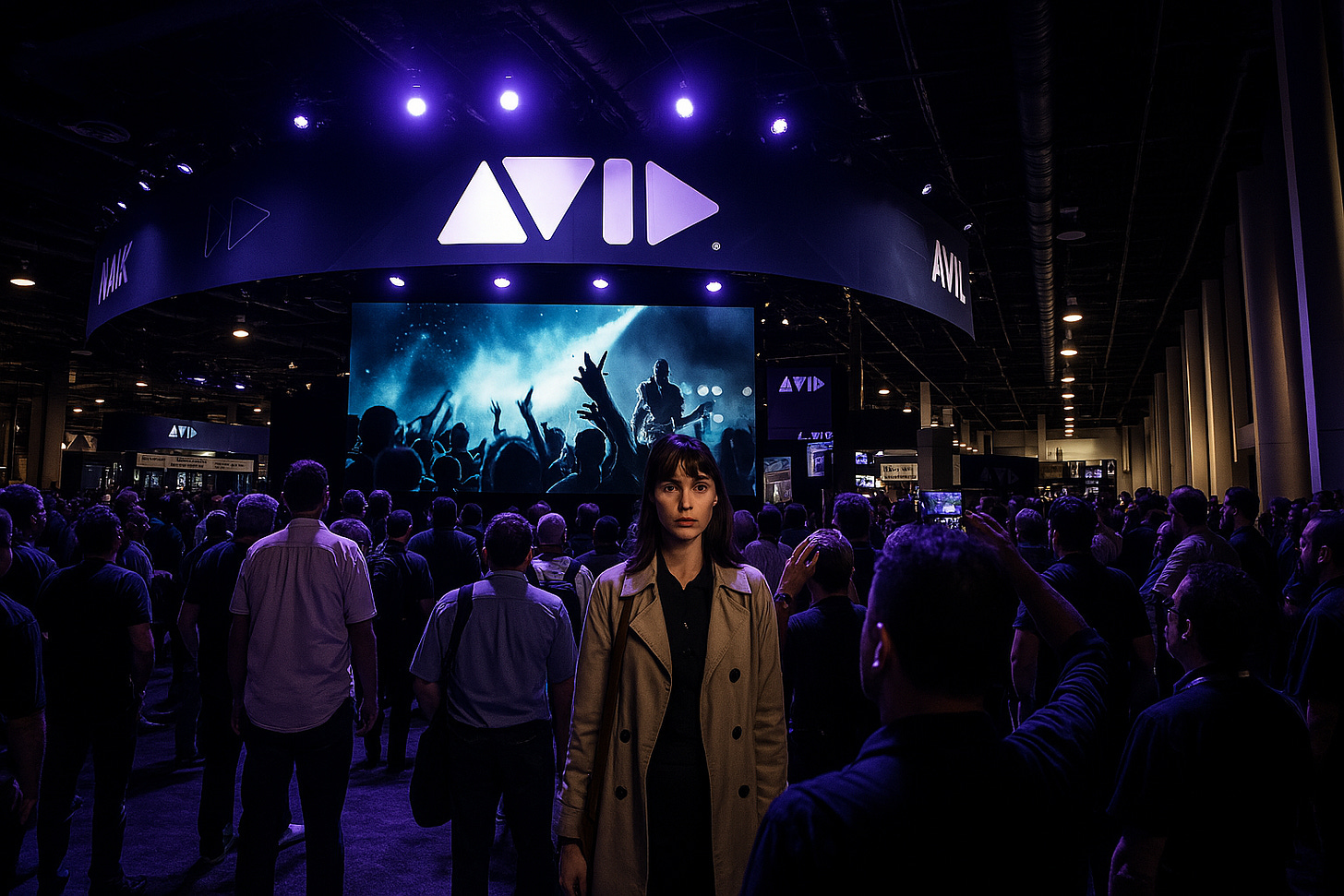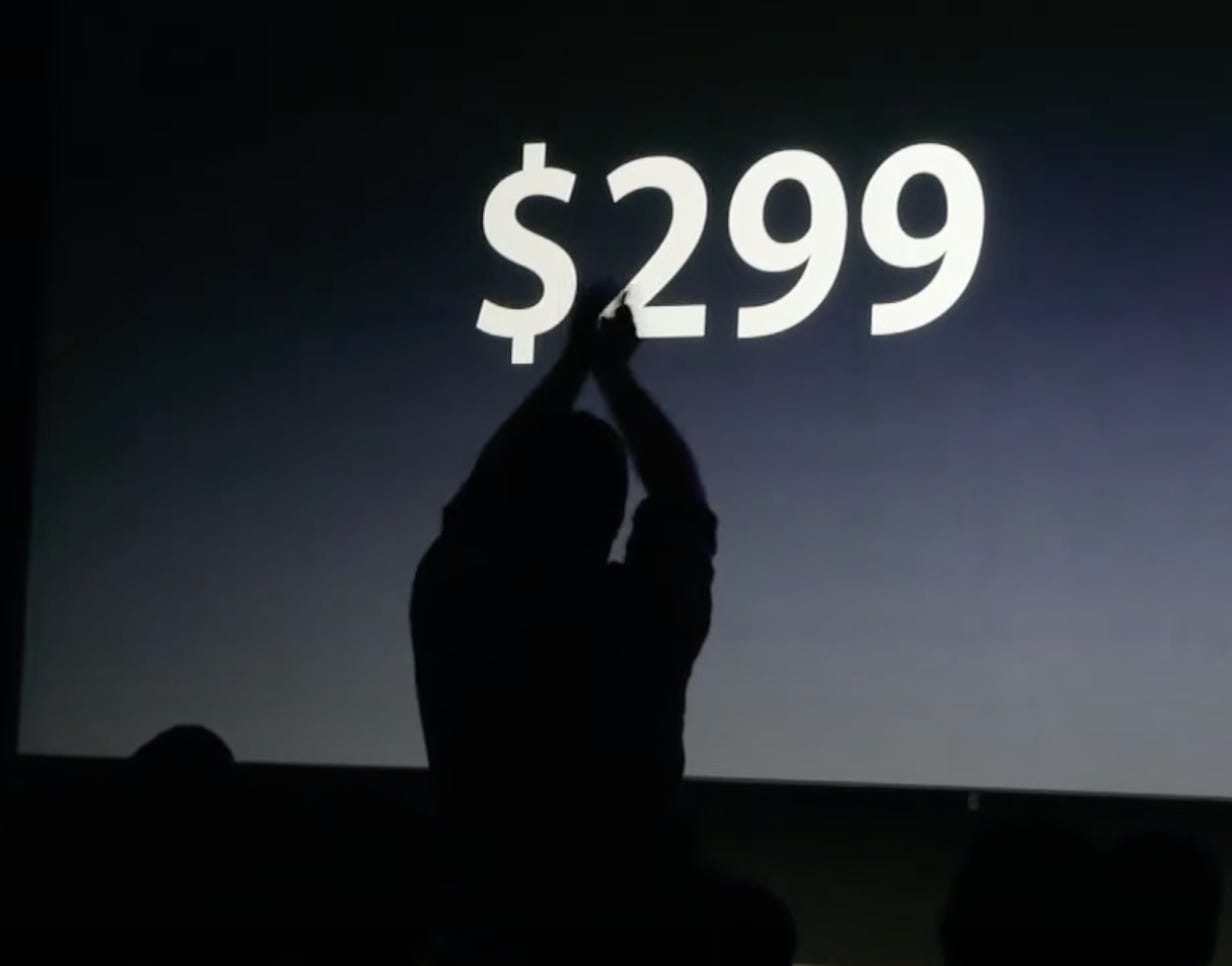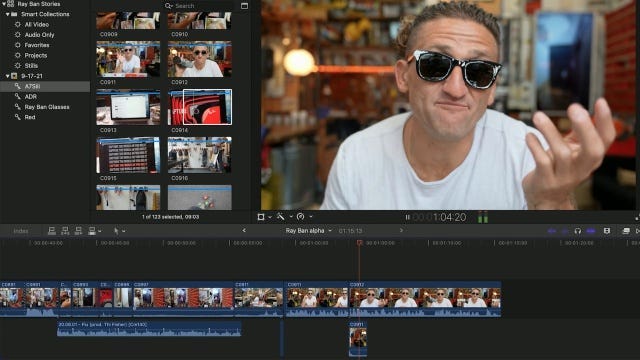An Untold Look at the “Debacle” of FCP7 to X
A rollout that split the editing world in two
Hi everyone,
This week’s newsletter is a deep dive into one of the most controversial pivots in editing history: the launch of Final Cut Pro X. It’s a story of risk, rebellion, and a rollout that split the editing world in two. But what if that so-called debacle was actually the beginning of the future? Efosa takes us back to 2011 and walks us through what really happened, and why it still matters.
Meanwhile, it’s been a big week at Eddie AI with a trifecta of launches that brings “ChatGPT” capabilities (i.e. prompt-to-video edit) to the dominant video editors.
We officially launched Eddie integrations for Adobe Premiere, DaVinci Resolve, and (drumroll)... Final Cut Pro. One launch per day because, well, we like a little drama. (Note to self: never launch three products in three days ever again. We all now need a nap for 48 hours straight.) And if you haven’t seen Robbie’s (or Robbies’) acting genius in our launch videos, you’re missing out.
We’ve also made some meaningful changes to our free plan. You can now log, edit, and export up to two full projects every month, completely free! No credit card required. Invite your teammates, and you’ll get even more free credit when they sign up!
Now, over to Efosa who, fittingly, is reporting this week from Cannes.
— Shamir
April 2011. Las Vegas. A stage. A reveal. A gasp. And then… the fallout.
The launch of Final Cut Pro X didn’t just divide the editing world. It shattered it. Editors fled. Forums exploded. Legacy users cried betrayal. Apple, once the scrappy disruptor-turned-Hollywood darling, suddenly looked like it had fumbled the final reel.
That’s the story. Or was it? What if the launch of FCPX wasn’t a mistake, but the moment? The moment that, fifteen years later, quietly reshaped how content is created today.
This is the story with new eyes, clarified with the passage of time.
Act I: Ahead of the Timeline
Before Final Cut Pro X, editing was frozen in time.
Things were already digital. But the interface was analog at heart. Tracks. Bins. Timelines that looked like tape. Even Apple’s own Final Cut Pro 7 still clung to analog metaphors.
Enter Steve Bayes, Apple’s Senior Product Manager for Final Cut Pro, and before that, Avid’s first ever instructor. The guy who literally wrote The Avid Handbook. The guy who trained an entire generation of editors on non-linear editors.
He’d seen the old guard, helped build the tools they loved, but knew something needed to change.
“We didn’t want editing to be about operating equipment,” Bayes later said. “We wanted it to be about storytelling.”
But the deeper insight was this: the editor of tomorrow was not sitting in a post house. They were on a laptop, in a bedroom, in a park, with a DSLR and a YouTube login.
Apple didn’t want this user just to be an afterthought, they were the thought.
Act II: The Bet
Apple debated everything. Scrap the timeline? Rethink audio sync? What would an editor’s canvas look like if they weren’t shackled by filmstrips?
Before Final Cut Pro X, editing was like threading tape. Tracks for video. Tracks for audio. Everything had a lane, and moving one clip meant manually pushing or breaking everything else around it.
If you’ve ever knocked your audio out of sync because you slipped one frame too far, you know what I’m talking about.
From those early Apple debates came the Magnetic Timeline.
A new way of editing where clips snapped into place, audio stayed in sync, and the visual flow stayed clean and logical. No more micromanaging tracks. No more nudging audio by a frame.
Clips aren’t shackled to rigid tracks. Instead, they're connected in storylines. Modular containers where clips magnetize to one another. Move one, and the rest ripple around it. Dialogue follows picture. Music follows edit. Sync is protected.
Instead of scrolling through a mess of layers and keyframes, you're sculpting moments that behave like scenes.
At first glance, it looked like chaos. But under the hood, it was something else entirely.
Radical. Elegant. Fast. But also deeply polarizing.
“Some of those features were controversial even inside the team,” Bayes said. “But we knew we were building something new. Not incrementally better, different.”
Instead of ‘bins’, you had Smart Collections. Instead of static timelines, you had dynamic ones.
They called it Final Cut Pro X. The 'X' was symbolic. Not just version ten. Not the next chapter. Not a follow-up. A complete reset.
An “X” stands for many things. A target. Danger. The one who got away. Or maybe the one who grew up and moved on after the breakup..
And at Apple, it was both Steves trying to steer that break.
Bayes wasn’t just another product lead in Cupertino. He was just two people removed from Jobs himself. And it was Jobs, famously allergic to legacy systems, who gave the first major greenlight to the FCPX overhaul.
“Apple wanted editors to be empowered, mobile, and agile, to edit anywhere, anytime, on their own terms,” Bayes said. “Creativity wasn’t going to live in big studios. It was going to live in backpacks.”
Act III: The Day Before Tomorrow - NAB Reveal
Date: April 12, 2011
Location: Las Vegas
Event: 10th Annual Supermeet - NAB show
The NAB (National Association of Broadcasters) show is the marquee event for video tech-heads. Think the Olympics, but for video pros who want to show off their finest new tech to the world.
Typically, the event involves keynote speakers, software demos, and product launches in the exhibition hall. Well, usually… But the 2011 show was different and at the time few people knew why.
One of those few was Bill Davis.
He had crossed paths with Steve Bayes over the years as one of the front running Final Cut Pro thought leaders, having spent more than a decade lecturing, contributing, and reporting on all things digital video.
Bill worked the floor at the NAB alongside running his own production company and he started to notice something awry.
Bill recounts, “There were a lot more people than usual crammed on the floor. Hundreds more. Many peculiar figures”.
Bill and his team had frequented NAB for many years meaning there were very few people he didn’t recognize.
There was one lady, in particular, who stood out.
Did she work there? Was she a last-minute technician? A spy?
Bill wasn’t sure either. “I’d gone to the NAB for years and you have a general sense of who’s who. Even if you didn’t know someone you could always gauge what their role was.”
It turns out that the lady was a press officer and over the next few hours leading up to the main hall opening, more of these unexpected visitors would dart around the venue.
Something was clearly afoot: waves of press usually only come to the NAB when something big is about to happen.
To make things all the more suspicious and suspenseful, the door leading to the main stage remained locked and Bill wasn’t permitted entry. That had never happened before.
Bill was manning the main door, staring out at thousands of eager tech-heads trying to clamor their way in. But what was he guarding the gates to? He didn’t even know.
An announcement felt imminent. The doors slam OPEN.
There’s Steve Bayes right in front row with the entire Apple FCP team.
After 5 minutes of frantic rushing to seats, Randy Ubilos — the creator of Final Cut Pro — takes to the stage, unveils Final Cut Pro X, and three words glaze the large screen…The Magnetic Timeline
The magnetic timeline allowed users the ability to cut video while keeping audio aligned within the timeline. It kept the editor in sync with the story, rather than the “edit”. It was intuition and storytelling in favor of just a “cut”.
The exhibition floor gasped: this simply had never been done before.
You had some of the best editors in the world in the room but they had no idea what they were looking at. Clips snapped into place. Audio remained in sync. Tracks gone. It looked and felt radical.
Surely software this groundbreaking would cost thousands of dollars? Cue the second shock around the room.
To put that figure into context, the previous iteration of FCP7 was $999.
So you had brand new technology at extremely low cost, enabling editors to work faster and more intuitively. What could possibly go wrong?
ACT IV: The Fallout
John most likely wasn’t serious. But no doubt some people were.
Apple killed Final Cut Pro 7 the same day it launched X. No cross-fade. No dissolve. Just a hard cut.
“Editors took it personally. It hurt,” Davis recalled. “They built careers on FCP7. It felt like losing an old friend.”
Adobe seized the moment, offering FCP users who defected to their editing software, Premiere, 50% discounts. And defect they did, by the thousands.
Bayes expected backlash. What he didn’t expect was the narrative: that FCPX was broken.
“We knew it wasn’t for everyone, yet. But we were building for five years down the road, not five weeks,” he said.
But in Cupertino, vision beats caution. If the future is coming, Apple doesn’t ease you into it, they shove you forward and expect you to catch up. Remember when they removed the CD-ROM/DVD drive from laptops or the headphone jack on the iPhone?
ACT V: A Hard Cut
Randy Ubilos. The legendary software architect behind not one, but two editing revolutions. Before Final Cut, he built Adobe Premiere. After Apple acquired Macromedia’s editing software in 1998, it was Ubilos who transformed it into Final Cut Pro. He knew what was coming for Final Cut. He’d tried pitching a slower rollout. Bundle Final Cut 7 with X, ease editors into the future. Apple wasn't interested. "Feet first, jump in," Randy said later.
Sixteen months before launch, he knew he'd be the one blamed when editors woke up to software they didn't recognize.
The day after launch, chaos erupted. Steve Jobs called Randy at home, direct.
"What the heck is going on with this Final Cut X thing?" Jobs said.
Randy laid it out. The backlash, the confusion, the pitchforks. Maybe they should've softened the blow, released FAQs, kept FCP7 around. Jobs listened. Paused. Then asked one question.
"Do you believe in this?"
Randy didn’t hesitate. "Yes."
"Then I do too," Jobs said.
That was it. No more debate. No second guessing. Just a green light from the top. Apple had jumped and Randy and Steve Jobs were holding hands on the way down.
ACT VI: The YouTube Effect: How FCPX Became the Creator’s Canvas
While Hollywood editors recoiled at Final Cut Pro X, another group began to embrace it. The Creator Class
Creators like Marques Brownlee, Emma Chamberlain, and Casey Neistat weren’t bound by the old. They didn’t care about multicam support (at least not yet). They cared about getting their stories out quickly and effectively. For them, Final Cut Pro X wasn’t a betrayal, it was liberation.
Marques is one of YouTube’s most iconic tech reviewers and built his entire workflow and 20 million subscribers following on Final Cut Pro.
Where would the timeline of content creation be without Casey? Marques, Emma, and Casey weren’t anomalies.
They were the proof of concept. Creators everywhere started cutting polished content between classes, after shifts, in the dead hours of the night. No studio. No crew. Just taste, timing, and the will to hit upload.
In the last decade, filmmaking didn’t just get cheaper, it got pocket-sized. The iPhone put a cinematic camera in everyone’s hand. YouTube, Instagram, and TikTok all opened the floor for the democratization of distribution.
Now the barrier isn’t budget. It’s time and workflow. You can literally take the same device you might be reading this on and shoot a movie today, edit it tomorrow during the day, then upload at night.
That simply was unfathomable 25 years ago and it’s the advent of software like FCP that helped turn that pipe dream into a reality.
Credits Roll
Steve Bayes retired from Apple in 2018 after 12 and a half years shaping the future of editing from the inside. These days, he lends his expertise to new tools and new voices—quietly guiding the next wave of post-production innovation from behind the curtain.
Bill Davis (no relation to anyone currently on the Apple Pro Apps team!) never stopped advocating. As a producer, narrator, and long-time voice in the Final Cut community, he continues to tell the story of FCPX the way he always saw it: not as a failure, but a misunderstood leap forward. While others moved on, Bill stayed in the trenches—editing, lecturing, tweeting—reminding us all that sometimes, the future just needs a second pass.
Randy Ubillos, the architect behind Final Cut Pro, iMovie, and much of Apple's groundbreaking video software, left Apple in 2015. Today, he's an app developer, entrepreneur, and independent consultant who still loves solving problems that others haven't even recognized yet.
The Final Cut?
Final Cut Pro X stood alone for 13 years but recently Apple decided to take another step forward with AI and a new version, Final Cut Pro 11.
What started with a bold interface and a missing save button is now brushing up against something bigger: Real-time voice isolation. Magnetic Mask. Spatial editing. It’s not science fiction. It’s the latest update.
The magnetic timeline still remains. As does the one-time $299 price.
AI is creating a lot of opportunities to allow more people to create and tell their story. And no one’s really certain how this book ends, especially for video editing software.
But one thing is certain: This won’t be the final cut.
Extra’s
We hope you enjoyed our latest long form essay, and if you’re craving other solid reads, here’s a few Substacks we’re digging this week.












I was a beta-tester on FCP X months before NAB, and quoted in a slide during the public announcement. I can add never-before-shared context on the development and launch.
Feels like P.R..
A whole industry of cinema; editing houses; vocational education; third party software; advanced storage and networking, tech-farm gear and IT implementation and support; university film departments, died a sudden unexpected death. Final Cut Pro X was a completely incompatible, hollowed out buggy toad doopie of an editing specimen that every carcass of the slaughtered masses derisively monikered, "iMovie Pro".
Apple had quietly dumped their development team, many of them known to the community, the production houses and convention goers. Up until this time nervousness had festered for almost two years as the next promised version of Final Cut Studio never came, never came....
Then the ax came down. The next "version" wasn't Final Cut Pro in any way, shape or form. Apple subsequently locked the EOL FCP out of new hardware and OS upgrades, leaving people around the world stranded with old, unfinished and archived projects across a storage landscape, that they cannot open to this day (not without breaking finished and rendered projects, third party integrations and all). Apple never released the source code (not that anyone expected them to -- but to this day it sure would be nice simply for legacy access).
One cannot overstate how destructive that all was. At first the thought was Apple uppers were completely out of touch with what their own product really was. (True.) Then it became clear that, despite the enormity of Final Cut Pro internationally in film and television, for the gargantuan Apple it was dust mote of a pet project compared to iPhones and all things Mac. The professional and technological ecosystem required to keep the world of Final Cut going wasn't worth it to Apple, they just wanted to back out of it and turn it over to, well, a consumer and prosumer Apple fanboy iMovie crowd.
Horribly handled. Cruel even. The blindsided industry went into triage, rebuilding infrastructure from the cement block up. Half the crowd slunk back to Avid, the other half fueled Premiere Pro's rise to become a dominant player. (A few years later Davinci branched out from the industry standard grading system into the professional editing sphere, and has been most successful at pulling people back from the other players to a true Final Cut Pro-like "industry" universe of powerful and accessible tools and attendant international community, that continues to expand and impress to this day. Final Cut never retook it's top spot in film and television.)
Apple was fine with all this. They didn't want to bother with it. To wit, Avid, Blackmagic and even Adobe are itty -bitty outfits compared to Cupertino. iPhone users outnumbered industry professionals twenty to one.